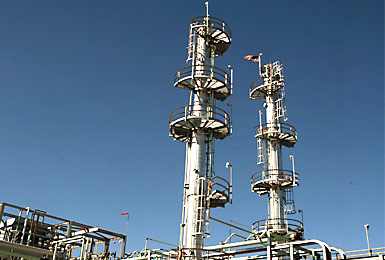Biofuels and the U.S. Navy's "Great Green Fleet"
A series of increasingly demanding Navy biofuel tests culminated in July 2012 with a task force of U.S. Navy ships and aircraft operating off the West Coast powered by biofuels.
August 2012

A series of increasingly demanding Navy biofuel tests culminated in July 2012 with a task force of U.S. Navy ships and aircraft operating off the West Coast powered by biofuels. This "Green Strike Group" evaluated the functionality of biofuels and served as the "final exam" for the Navy's biofuel program. The biofuels performed flawlessly in ships, fighter planes, and helicopters as planned. The Green Strike Group is part of the Rim of the Pacific exercise near Hawaii. Conducted every other year, this is the world's largest maritime exercise. Navies of several U.S. allies take part.
Solazyme, Inc., headquartered in South San Francisco, converts algae and food processing wastes into biofuels. In March the Navy's frigate USS Ford successfully used Soladiesel HRD-76 to power its diesel turbine engines on a voyage from Everett, Washington, to San Diego. The Navy's most advanced fighter plane, the FA-18, and several other types of aircraft have also tested biofuels.
Using Solazyme's Bio-Synfining™ process, Dynamic Fuels LLC is converting beef tallow and chicken fat into synthetic diesel fuel. Some of this is being converted into jet fuel, resulting in a total production of 100,000 gallons of jet fuel and 350,000 gallons of diesel marine distillate fuel at its plant in Geismar, Louisiana. The plant, a 50:50 Solazyme-Tyson Foods joint venture, employs 300 people. Delivery to supply the fuel needed for the Navy's 2012 fleet tests took place in May. Geismar is already a major petrochemical center and has excellent transportation connections, being on both the Mississippi River and a major interstate highway, I-10, and having good rail connections as well.
Though miniscule compared to the Navy's annual fuel demand of 1.26 billion gallons, the 450,000 gallons of biofuel on order for 2012 are a key milestone in developing economies of scale and reducing biofuel costs to levels comparable to conventional fuels based on petroleum.
The Green Strike Group isn't the end of the biofuels program. The Navy intends to have an entire fleet of warships known as the "Great Green Fleet" running on biofuels by 2016. The goal is to have half the entire Navy running on biofuels by 2020.
A major aim of the Navy program is to integrate different kinds of non-food feedstocks into standardized biofuels. This could help scale up global biofuel production more rapidly than a single-feedstock focus. A $510 million partnership between the departments of Agriculture, Energy, and Navy and private-sector firms is designed to help build a growing supply of domestic biofuel made from nonfuel sources, while creating new jobs in biorefining, transportation, and related operations, particularly in rural areas.
Project Announcements
ValorFlex Packaging Plans Bowling Green, Kentucky, Production Operations
06/30/2025
Neuro.io Plans Terrebonne Parish, Louisiana, Operations
06/30/2025
Germany-Based MTU Maintenance Expands Fort Worth, Texas, MRO Operations
06/30/2025
Cascade Die Casting Group Expands High Point, North Carolina, Manufacturing Operations
06/30/2025
BuildOps Plans Raleigh, North Carolina, Operations
06/30/2025
Point Blank Enterprises Plans Wakulla County, Florida, Operations
06/30/2025
Most Read
-
20th Annual Area Development Gold and Silver Shovel Awards
Q2 2025
-
First Person: Joe Capes, CEO, LiquidStack
Q2 2025
-
The Legal Limits of DEI in Incentives Agreements, Hiring, and Contracting
Q2 2025
-
From Silicon to Server: Mapping the Data Center Supply Chain
Q2 2025
-
39th Annual Corporate & 21st Annual Consultants Surveys: What Business Leaders and Consultants Are Saying About Site Selection
Q1 2025
-
Rethinking Life Sciences Site Selection in a Resilient and Dynamic Market
Q2 2025
-
Top States for Doing Business in 2024: A Continued Legacy of Excellence
Q3 2024



